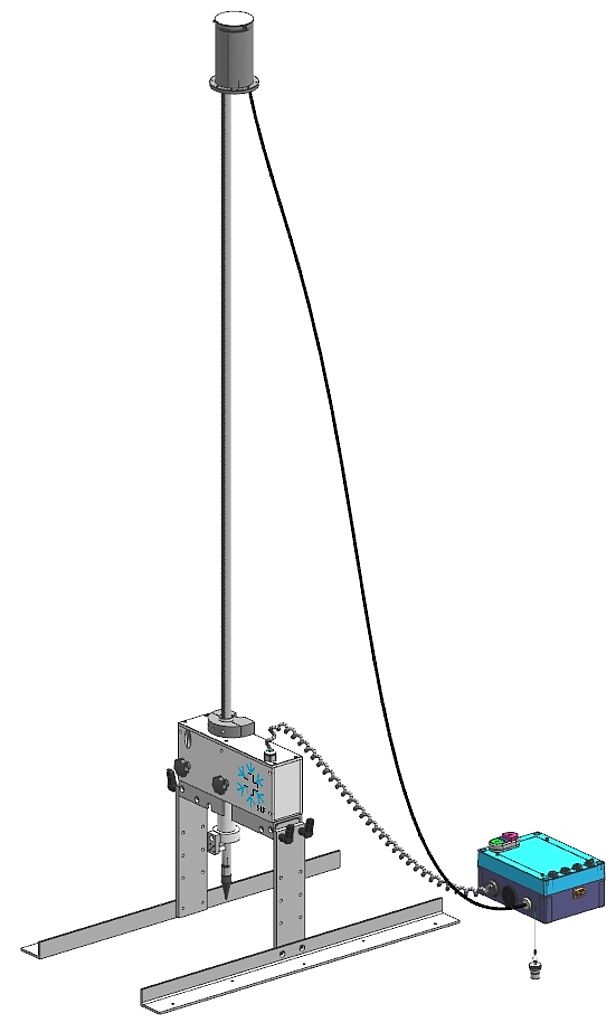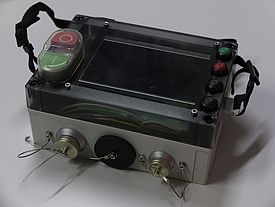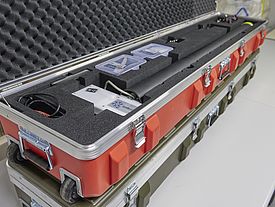The SnowMicroPen (SMP, Figure 1) is a variant of a cone penetrometer to measure bonding forces between snow grains at high spatial resolution.
The SMP is developed by the WSL Institute for Snow and Avalanche Research SLF and used for different applications such as snow profiling (avalanche forecasting, snow stratigraphy, ground truth for remote sensing), ski track characterization (ski racing) or snow runway characterization (stability testing).
The instrument is mainly developed for field measurements and specifically designed for operation at low temperatures (-30°C).
As a unique feature, the SMP facilitates a fast and objective characterization of the snow stratigraphy, a profile measurement for a snowpack of 1.25 m takes around two minutes.
Costs and ordering ¶
Ask for a quote at SnowMicroPen(at)slf.ch.
Price details will be provided upon request. The delivery time is about 6 months.
Measurement Principle ¶
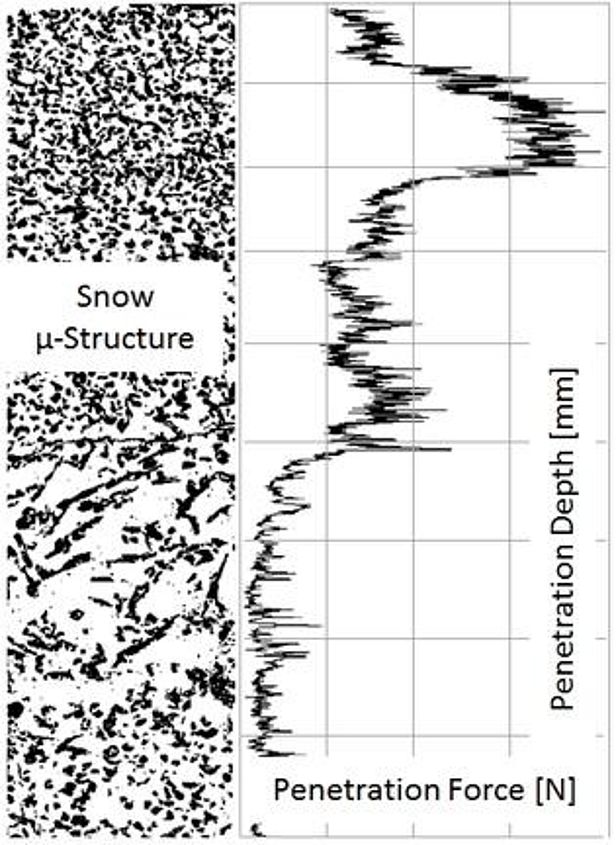
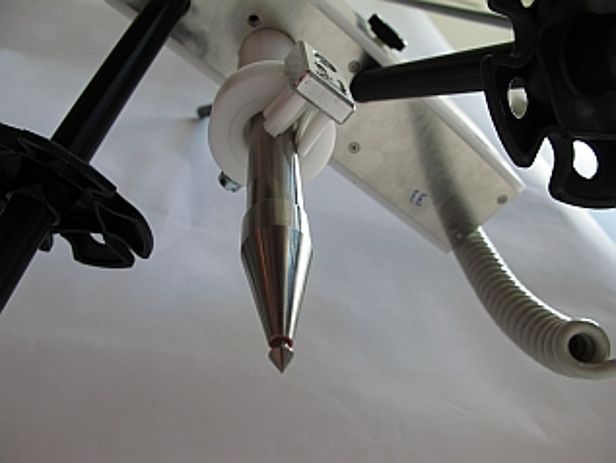
To obtain the microstructural information, the SMP drives a rod with a force sensor into the snow and samples the penetration force every 4 micrometers. The force exerted on the tip is a superposition of bond breaking and snow compression.
An example of the measured force signal is shown in Figure 2.
To illustrate the influence of snow type and layering on the penetration resistance, the signal is aligned with the snow microstructure as seen by micro-computed tomography.
Technically, the SMP mainly consists of a mechanical and a controller unit.
Mechanical unit
The mechanical unit of the SMP comprises the motor and the rod. The metallic rod encloses the piezo-electric force sensor (Kistler Instrumente, sensor type 9207) at its bottom. A thin conical metal tip is attached to the force sensor at the end of the rod for the transmission of the penetration force (see Fig. 3). During a measurement, the rod is penetrating into the snow while the force on the tip is measured.
The rod is driven with a constant speed of approximately 20 mm/s until a user-defined "penetration depth" is reached or an overload force is detected.
To ensure high accuracy in the vertical position, force measurements are triggered by the encoder of the motor. Thereby, natural variations in the penetration speed (e.g. at the transition to a very hard layer) can be compensated.
When the rod is driven back out of the snow, a small brush removes the snow from the gear teeth to avoid jamming of the motor and the rod.
For a stable position of the device during a measurement, ski poles (included) can be mounted on the unit to place it on the snow surface. In addition, the device is shipped with a metal frame for improved operation on hard snow. The metal frame also allows deployment on auxiliary vehicles.
Controller Unit ¶
A measurement can be started and stopped from the controller unit. After the measurement, a live-view of the penetration force vs depth is displayed and the data is stored on a SD card.
Additonal controller menus provide access to manual rod controls, penetration depth limits and other instrument settings. The 4-button navigation is easily possible even with thick gloves which supports the operation in the field at low temperatures.
The controller contains a Li-Polymer battery which is designed for an entire day of SMP measurements. An additional, external battery can be connected to the controller unit which is recommended when operating the SMP in very cold conditions (-40°C). The external battery can be carried in the pocket of the jacket to keep it warm and avoid performance issues.
Specifications ¶
| Parameter | Unit | Value |
|---|---|---|
| Measurable snow depth | [m] | 0.27, 0.83, 1.25 (default), 1.72 or 2.2 |
| Vertical penetration velocity | [mm/s] | 20 |
| Vertical sampling resolution | [µm] | 4 |
| Vertical layer resolution | [mm] | 0.5 |
| Force range seasonal snow | [N] | 0 .. 50 (Range II), 0 .. 75 (Range I) |
| Force range technical snow | [N] | 0 .. 500 |
| Force resolution seasonal snow | [N] | 0.01 |
| Force resolution technical snow | [N] | 0.05 |
| Operating temperature | [°C] | -30 .. 40 |
| Moisture | [-] | Avoid condensation on the device |
| GPS | [-] | Included, for UTC time stamp (and coordinates) |
| Power | [-] | IcePowered Li-Po battery (full performance down to temperatures of -20°C) |
| Data storage and handling | [-] | FAT32 file system on SD card, SD-USB card reader |
| Approx. weight for field use | [kg] | 7 |
| Approx. weight for transportation | [kg] | 25 |
Transport and packaging ¶
The rod is made of a single piece that cannot be split into smaller sections. Depending on the rod length, the SnowMicroPen is shipped with a hard case or a ski bag for transportation of the full system. The tip should always be removed to protect the force sensor during transport.
In addition to the case, the SMP is delivered with a protection tube for the rod, which can be easily fixed on a backpack.
Data Handling
The penetration force and depth are written to binary files (*.pnt) which are stored on a commercial SD card. The measurement files can be easily copied to a computer with a "SD-USB" adapter. A Python based file reader is provided. In addition, a small software package is available.
An SMP measurement at a glance
A measurement comprises the following steps:
- Make sure that the battery is charged
- Make sure that the SD memory card with the configuration file is in the controller unit
- Make sure that the device is thermally equilibrated with the measurement environment
- Connect the mechanical unit and controller unit (2 cables)
- Switch on the controller unit
- Make sure that the tip is correctly mounted
- Attach the brush
- Use the ski-poles or the frame to hold the SMP in position
- Measure
Two examples of field measurements with the SMP using either poles or a deployment on skis for positioning are shown in Fig. 5 and 6.
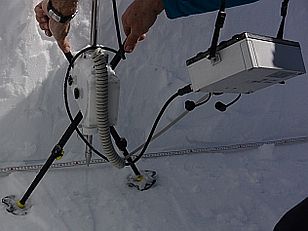
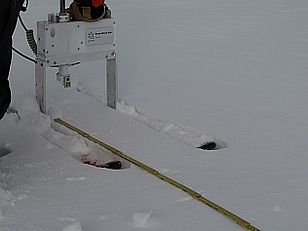
Known problems
The operation at warm temperatures (~0 °C) can cause problems if liquid water in the snowpack re-freezes on the tip or the gear teeth, which makes measuring impossible. In addition, temperature gradients in the sensor may cause a drift in the signal.
Possible applications of the SMP ¶
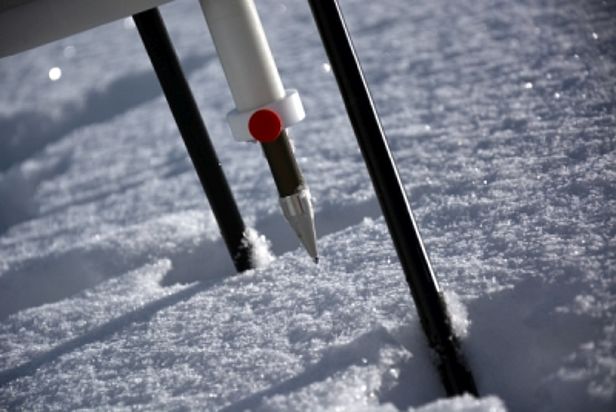
SnowMicroPen
Wir verwenden es zur Untersuchung der Lawinenbildung, bei Expedition in die Polargebiete und um Radarmessungen und Schneeprofile besser zu verstehen. Ein Portrait eines „Instrument in progress“.
Costs and Ordering ¶
Price details will be provided upon request.
Order at SnowMicroPen(at)slf.ch - delivery time is about 6 months.
Contact ¶
All requests should be sent to SnowMicroPen(at)slf.ch
For administrative questions, offers, data analysis, ...:
- Martin Schneebeli
For technical support or repair:
- Matthias Jaggi
